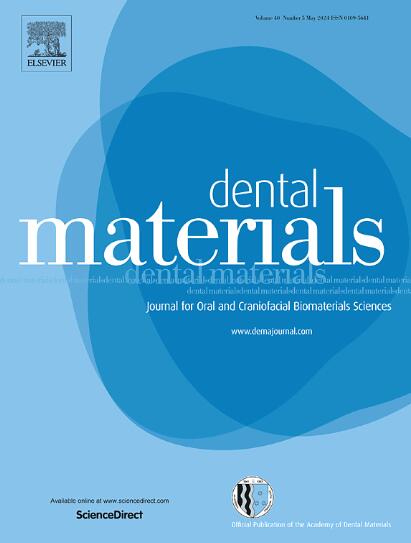胶体铂纳米粒子可增强树脂-牙本质粘接的耐久性。
IF 4.6
1区 医学
Q1 DENTISTRY, ORAL SURGERY & MEDICINE
引用次数: 0
摘要
研究目的本研究旨在探讨胶体铂纳米粒子(CPN)对当代粘合剂的树脂-牙本质粘接性能的耐久性的影响:方法:对 60 颗未龋坏的人类上颌前磨牙进行微拉伸粘接强度(µTBS)测试,并将其分为两大组:CPN 处理组和未处理组。在每组中,试样被随机分配到 Clearfil Megabond 2 (MB2)、Scotchbond Universal Plus 粘接剂自酸洗模式 (SE-SUP) 和酸洗-冲洗模式 (ER-SUP) 亚组(n = 10/组)。在 MB2 和 SE-SUP 组中,CPN 在牙本质上涂抹 20 秒,然后在涂抹粘合剂前冲洗。在 ER-SUP 组中,CPN 是在蚀刻-冲洗后使用的。分别在 24 小时、6 个月和 1 年后测试 µTBS,并使用扫描电镜观察断裂模式。µTBS 数据采用双向方差分析和事后 Tukey HSD 检验(α = 0.05)进行分析。另外还对 12 颗前臼齿进行了 TEM/STEM/EDX 超形态观察:结果:使用氯化萘可明显防止 MB2 组和 SE-SUP 组 µTBS 的下降。在 ER-SUP 组中,无论是老化还是使用 CPN,都没有观察到明显的下降。超微形态学图像显示,无论老化与否,铂纳米粒子都附着在混合层的胶原纤维上。突出显示的是,在老化组中观察到纳米颗粒附着在带状胶原上:在 SE 模式下,CPN 具有提高树脂-牙本质粘接寿命的潜力。本文章由计算机程序翻译,如有差异,请以英文原文为准。
Colloidal platinum nanoparticles enhance resin-dentin bonding durability
Objectives
This study aims to investigate the effect of colloidal platinum nanoparticles (CPN) on the durability of resin-dentin bonding performance with contemporary adhesives.
Methods
Sixty non-carious human maxillary premolars were subjected to microtensile bond strength (µTBS) testing and divided into two main groups: CPN-treated and untreated. Within each group, specimens were randomly allocated to Clearfil Megabond 2 (MB2), Scotchbond Universal Plus Adhesive with self-etch mode (SE-SUP), and etch-and-rinse mode (ER-SUP) subgroups (n = 10/group). CPN was applied to dentin in the MB2 and SE-SUP groups for 20 s, followed by rinsing before adhesive application. In the ER-SUP group, CPN was applied after etch-and-rinse. The µTBS was tested after 24 h, 6 months, and 1 year, and the fracture modes were observed using SEM. The µTBS data were analyzed using a two-way ANOVA and post-hoc Tukey HSD test (α = 0.05). An additional twelve premolars underwent TEM/STEM/EDX for ultra-morphological observations.
Results
The application of CPN significantly prevented a decline in the µTBS of both the MB2 and SE-SUP groups. No significant decrease was observed in the ER-SUP group, either with aging or CPN application. Ultra-morphological images revealed platinum nanoparticles attaching to the collagen fibrils of the hybrid layer regardless of aging. It was highlighted that the nanoparticles attached to the banded collagen in the aging groups were observed.
Significance
CPN exhibits the potential in enhancing the longevity of resin-dentin bonding in SE mode.
求助全文
通过发布文献求助,成功后即可免费获取论文全文。
去求助
来源期刊

Dental Materials
工程技术-材料科学:生物材料
CiteScore
9.80
自引率
10.00%
发文量
290
审稿时长
67 days
期刊介绍:
Dental Materials publishes original research, review articles, and short communications.
Academy of Dental Materials members click here to register for free access to Dental Materials online.
The principal aim of Dental Materials is to promote rapid communication of scientific information between academia, industry, and the dental practitioner. Original Manuscripts on clinical and laboratory research of basic and applied character which focus on the properties or performance of dental materials or the reaction of host tissues to materials are given priority publication. Other acceptable topics include application technology in clinical dentistry and dental laboratory technology.
Comprehensive reviews and editorial commentaries on pertinent subjects will be considered.
 求助内容:
求助内容: 应助结果提醒方式:
应助结果提醒方式:


